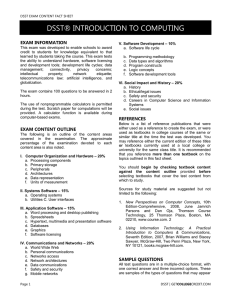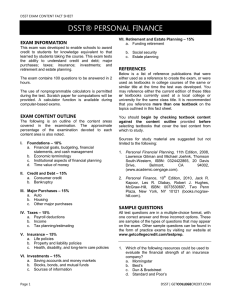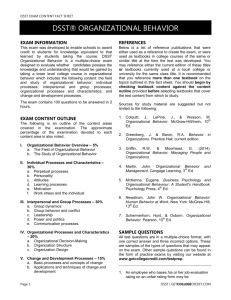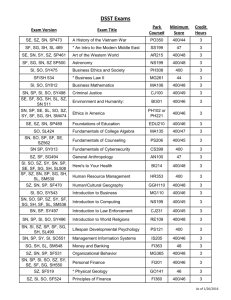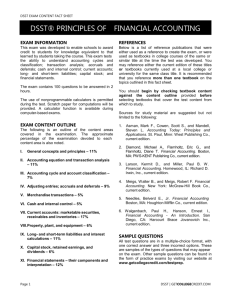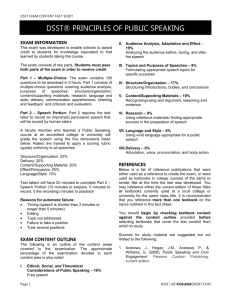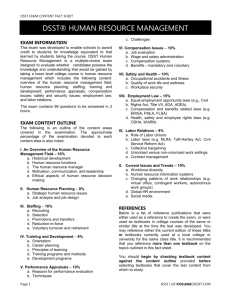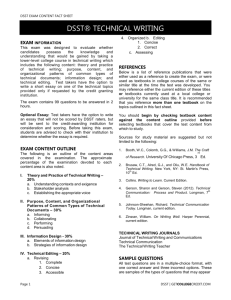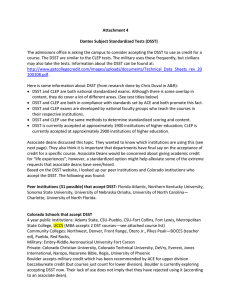DSST® PRINCIPLES OF FINANCE
advertisement
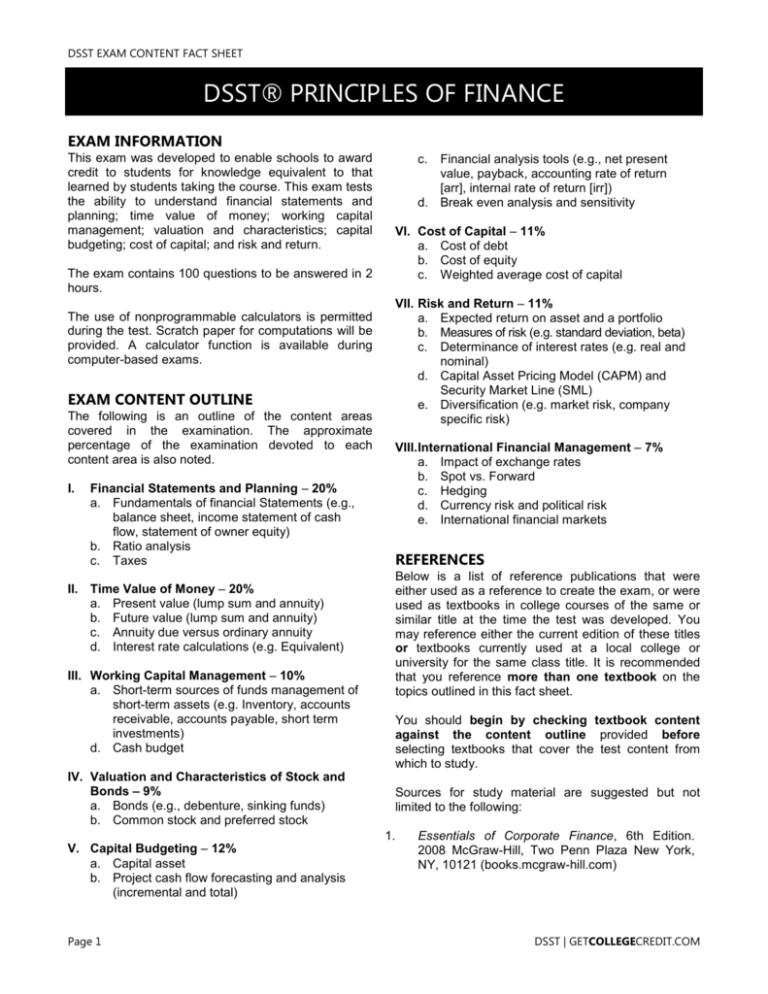
DSST EXAM CONTENT FACT SHEET DSST® PRINCIPLES OF FINANCE EXAM INFORMATION This exam was developed to enable schools to award credit to students for knowledge equivalent to that learned by students taking the course. This exam tests the ability to understand financial statements and planning; time value of money; working capital management; valuation and characteristics; capital budgeting; cost of capital; and risk and return. The exam contains 100 questions to be answered in 2 hours. The use of nonprogrammable calculators is permitted during the test. Scratch paper for computations will be provided. A calculator function is available during computer-based exams. EXAM CONTENT OUTLINE The following is an outline of the content areas covered in the examination. The approximate percentage of the examination devoted to each content area is also noted. I. Financial Statements and Planning – 20% a. Fundamentals of financial Statements (e.g., balance sheet, income statement of cash flow, statement of owner equity) b. Ratio analysis c. Taxes II. Time Value of Money – 20% a. Present value (lump sum and annuity) b. Future value (lump sum and annuity) c. Annuity due versus ordinary annuity d. Interest rate calculations (e.g. Equivalent) III. Working Capital Management – 10% a. Short-term sources of funds management of short-term assets (e.g. Inventory, accounts receivable, accounts payable, short term investments) d. Cash budget IV. Valuation and Characteristics of Stock and Bonds – 9% a. Bonds (e.g., debenture, sinking funds) b. Common stock and preferred stock c. Financial analysis tools (e.g., net present value, payback, accounting rate of return [arr], internal rate of return [irr]) d. Break even analysis and sensitivity VI. Cost of Capital – 11% a. Cost of debt b. Cost of equity c. Weighted average cost of capital VII. Risk and Return – 11% a. Expected return on asset and a portfolio b. Measures of risk (e.g. standard deviation, beta) c. Determinance of interest rates (e.g. real and nominal) d. Capital Asset Pricing Model (CAPM) and Security Market Line (SML) e. Diversification (e.g. market risk, company specific risk) VIII. International Financial Management – 7% a. Impact of exchange rates b. Spot vs. Forward c. Hedging d. Currency risk and political risk e. International financial markets REFERENCES Below is a list of reference publications that were either used as a reference to create the exam, or were used as textbooks in college courses of the same or similar title at the time the test was developed. You may reference either the current edition of these titles or textbooks currently used at a local college or university for the same class title. It is recommended that you reference more than one textbook on the topics outlined in this fact sheet. You should begin by checking textbook content against the content outline provided before selecting textbooks that cover the test content from which to study. Sources for study material are suggested but not limited to the following: 1. V. Capital Budgeting – 12% a. Capital asset b. Project cash flow forecasting and analysis (incremental and total) Page 1 Essentials of Corporate Finance, 6th Edition. 2008 McGraw-Hill, Two Penn Plaza New York, NY, 10121 (books.mcgraw-hill.com) DSST | GETCOLLEGECREDIT.COM DSST EXAM CONTENT FACT SHEET – PRINCIPLES OF FINANCE 2. Fundamentals of Financial Management, 11th Edition. 2007 South-Western, 20 Davis Drive, Belmont, CA, 94002 (academic.cengage.com) SAMPLE QUESTIONS All test questions are in a multiple-choice format, with one correct answer and three incorrect options. These are samples of the types of questions that may appear on the exam. Other sample questions can be found in the form of practice exams by visiting our website at www.getcollegecredit.com/testprep. 1. Which of the following statements is true about a stock split? a. It increases equity b. It decreases assets c. It increases retained earnings d. It decreases the par value of the stock 2. When a firm pays a cash dividend, the firm's balance sheet is affected in which of the following ways? a. Assets and equity remain the same b. Assets decrease and equity increases c. Assets and liabilities decrease d. Assets and equity decrease 3. The degree of financial leverage measures the responsiveness of a. Earnings to changes in operating expenses b. Earnings to changes in output c. Earnings before taxes to changes in operating income d. Operating income to changes in net income 4. In linear break-even analysis, a decrease in fixed costs, if other factors remain constant, will cause the break-even point and the degree of operating leverage to do which of the following? a. Increase decrease b. Decrease decrease c. Decrease increase d. Increase increase 5. Which of the following terms of trade credit is most favorable for the buyer? a. 2/15 net 30 b. 2/15 net 45 c. 3/10 net 30 d. 3/15 net 45 7. If the internal rate of return of two mutually exclusive investments is less than the firm's cost of capital, the firm should make which of the following investments, if any? a. The shorter term investment b. The investment with the lower internal rate of return c. The investment with the higher internal rate of return d. None of the above 8. Which of the following is associated with a stock dividend as opposed to a cash dividend? a. An increase in assets b. An increase in equity c. A decrease in assets d. No change in liabilities 9. The primary responsibility of a financial manager is to maximize the firm's a. stockholder wealth b. sales c. earnings d. profits 10. Which two of the following would be preferable to bond owners? I. Debt ratio of 50% rather than 20% II. Debt ratio of 20% rather than 50% III. Times-interest-earned of 2.0 rather than 5.0 IV. Times-interest-earned 5.0 rather than 2.0 a. b. c. d. I and III I and IV II and III II and IV 11. Which of the following will cause a currency outflow from the United States? a. The purchase of United States plants and equipment by Japanese investors b. The maintenance of United States military bases in Europe c. The trading of Japanese yen for United States dollars by Japanese investors d. The return of income from United States investments in Europe 6. The internal rate of return for a project will be higher if the a. cost of capital is lower b. cost of capital is higher c. initial investment is lower d. initial investment is higher Page 2 DSST | GETCOLLEGECREDIT.COM DSST EXAM CONTENT FACT SHEET – PRINCIPLES OF FINANCE CREDIT RECOMMENDATIONS The American Council on Education’s College Credit Recommendation Service (ACE CREDIT) has evaluated the DSST test development process and content of this exam. It has made the following recommendations: Area or Course Equivalent Level Principles of Finance Amount of Credit Minimum Score Three (3) semester hours Source American Council on Education – College Credit Recommendation Service Upper-level baccalaureate 400 Answers to sample questions: 1-D; 2-D; 3-C; 4-B; 5-D; 6C; 7-D; 8-D; 9-A; 10-D; 11-B. Rev 3/14 Page 3 DSST | GETCOLLEGECREDIT.COM
